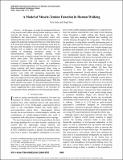| dc.contributor.author | Endo, Ken | |
| dc.contributor.author | Herr, Hugh M | |
| dc.date.accessioned | 2010-05-04T18:21:37Z | |
| dc.date.available | 2010-05-04T18:21:37Z | |
| dc.date.issued | 2009-07 | |
| dc.identifier.isbn | 978-1-4244-2788-8 | |
| dc.identifier.uri | http://hdl.handle.net/1721.1/54701 | |
| dc.description.abstract | In this paper, we study the mechanical behavior of leg muscles and tendons during human walking in order to motivate the design of economical robotic legs. We hypothesize that quasi-passive, series-elastic clutch units spanning the knee joint in a musculoskeletal arrangement can capture the dominant mechanical behaviors of the human knee in level-ground walking. Since the mechanical work done by the knee joint throughout a level-ground self-selected-speed walking cycle is negative, and since there is no element capable of dissipating mechanical energy in the musculoskeletal model, biarticular elements would necessarily need to transfer energy from the knee joint to hip and/or ankle joints. This mechanism would reduce the necessary actuator work and improve the mechanical economy of a human-like walking robot. As a preliminary evaluation of these hypotheses, we vary model parameters, or spring constants and clutch engagement times, using an optimization scheme that minimizes ankle and hip actuator positive work while still maintaining human-like knee mechanics. For model evaluation, kinetic and kinematic gait data were employed from one study participant walking across a level-ground surface at a self-selected gait speed. With this under-actuated leg model, we find good agreement between the model's quasi-passive knee torque and experimental knee values, suggesting that a knee actuator is not necessary for level-ground robotic ambulation at self-selected gait speeds. | en |
| dc.language.iso | en_US | |
| dc.publisher | Institute of Electrical and Electronics Engineers | en |
| dc.relation.isversionof | http://dx.doi.org/10.1109/ROBOT.2009.5152622 | en |
| dc.rights | Article is made available in accordance with the publisher's policy and may be subject to US copyright law. Please refer to the publisher's site for terms of use. | en |
| dc.source | IEEE | en |
| dc.title | A model of muscle-tendon function in human walking | en |
| dc.type | Article | en |
| dc.identifier.citation | Endo, K., and H. Herr. “A model of muscle-tendon function in human walking.” Robotics and Automation, 2009. ICRA '09. IEEE International Conference on. 2009. 1909-1915. © 2009 IEEE | en |
| dc.contributor.department | Harvard University--MIT Division of Health Sciences and Technology | en_US |
| dc.contributor.department | Massachusetts Institute of Technology. Department of Electrical Engineering and Computer Science | en_US |
| dc.contributor.department | Massachusetts Institute of Technology. Media Laboratory | en_US |
| dc.contributor.department | Program in Media Arts and Sciences (Massachusetts Institute of Technology) | en_US |
| dc.contributor.department | Massachusetts Institute of Technology. Media Laboratory. Biomechatronics Group | en_US |
| dc.contributor.approver | Herr, Hugh M. | |
| dc.contributor.mitauthor | Endo, Ken | |
| dc.contributor.mitauthor | Herr, Hugh M. | |
| dc.relation.journal | IEEE International Conference on Robotics and Automation, 2009. ICRA '09. | en |
| dc.eprint.version | Final published version | en |
| dc.type.uri | http://purl.org/eprint/type/ConferencePaper | en |
| eprint.status | http://purl.org/eprint/status/PeerReviewed | en |
| dspace.orderedauthors | Endo, K.; Herr, H. | en |
| dc.identifier.orcid | https://orcid.org/0000-0003-3169-1011 | |
| mit.license | PUBLISHER_POLICY | en |
| mit.metadata.status | Complete | |
